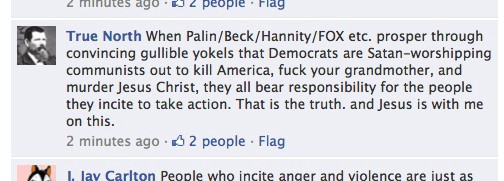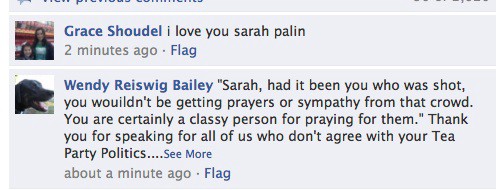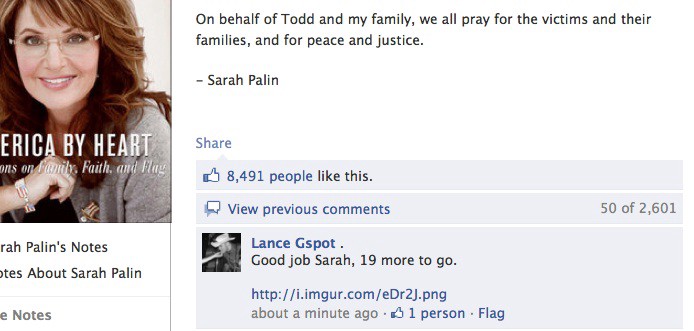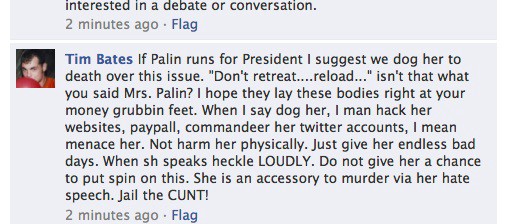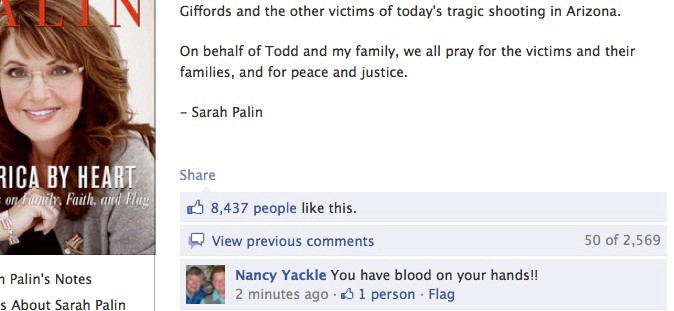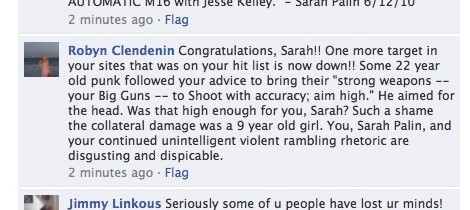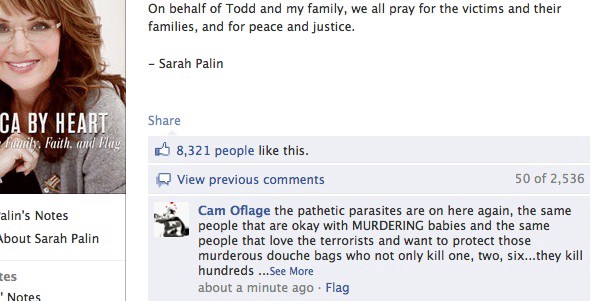The Aliens Are Going To Use Us All For Parts
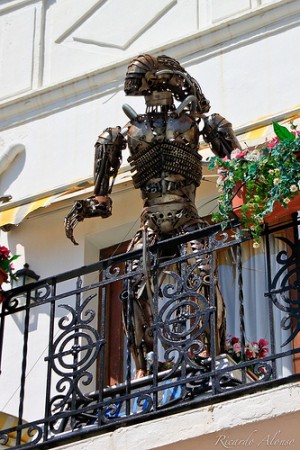
Here’s a new thing to fear:
When considering the prospect of alien life, humankind should prepare for the worst, according to a new study: Either we’re alone, or any aliens out there are acquisitive and resource-hungry, just like us.
These two unpalatable options are pretty much the only possibilities, according to the new study. That’s because evolution is predictable, and alien biospheres should thus produce intelligent creatures much like us, with technological prowess and an ever-increasing need for resources.
That is terrifying enough on its own, but grows considerably more horrific when you consider how probe-happy your average alien is. Be afraid!
Photo by Ricardo Alonso, from Flickr.
Bad Mommyblogging
The world’s worst mommy blogger: “Little Harrison is here! I was going to post a photo but he’s not looking his best yet. As soon as he burst out I thought, ‘Oh great, Grandpa Wenmouth’s nose.’ That was my worst fear (Sandy also has Wenmouth’s nose, and we like to tease her about it: Oh, Sandy, you’d be so pretty if you were more symmetrical! I hope you don’t want to be an actress! It’s hilarious, she’ll love it when she’s old enough to appreciate it), so every day I’m pushing it a little to the left and hoping that it sticks. When they’re young their faces are so malleable.”
Long Distance Projection: Believers Making Sense of Jared Lee Loughner
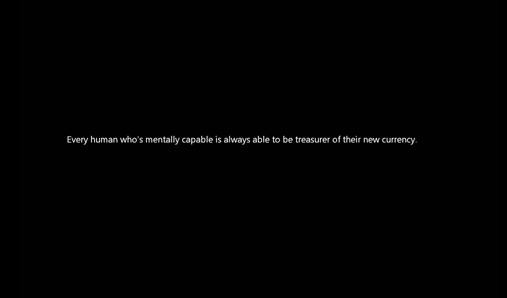
Truly senseless acts make for poor sloganeering. Jared Lee Loughner, the gunman who killed six people at a Tucson congressional town meeting, while gravely wounding his apparent target, Democratic Rep. Gabrielle Giffords, seems to have been not at all working from any traditional set of motivations. His now-infamous cache of YouTube videos throws around theories of a new currency and the illegitimate seizure of private property, together with a barely intelligible discussion of himself as a terrorist. He also announced plans to introduce a new number and letter to the alphabet, both represented as bursts of incoherent scribbling — a fair depiction, it seems, of the thought process involved in producing these conceptual breakthroughs. Loughner also described himself as a “conscience dreamer,” though it’s unclear whether he meant that as a sideways indictment of the absence of ethical probity in American life, or simply couldn’t spell “conscious.”
Nevertheless, even a very “different” worldview can be made to serve as a stand-in for one’s pet nemesis in the toy-soldier confrontation. Since Giffords was among the lawmakers featured in the crosshairs-graphics on SarahPAC’s thuggish pitch to unseat pro-health-reform Democrats from districts that went Republican in the 2008 presidential vote, many left-leaning commentators rushed to equate Loughner’s act with tea-party rhetoric run amok. (Palin’s operation has since scrubbed the graphic from the SarahPAC site, with typically dishonest and self-dramatizing flourishes.) Commentators on the right rallied just as briskly to deride “the media” — the right’s own scapegoat of first resort in culture-war agons — for dragging Palin and the Tea Party into the picture. Conservatives gleefully noted that Loughner counted The Communist Manifesto among his favorite books; the left sniped back that he also included Ayn Rand’s gruesome objectivist fantasy We the Living on the same list. Both sides pinned Mein Kampf on the opposition, in strict adherence to Godwin’s law. (Inexplicably, neither political tendency has come forward to denounce the other incendiary literary entries on Loughner’s YouTube profile; The Old Man and the Sea, after all, is a blueprint for violent mayhem right up there with The Anarchist’s Cookbook — and The Phantom Tollbooth may as well be subtitled “The Turner Diaries.”)
Most of this rampant political branding of the Despised Other can, and should, be written off to the desperate point-scoring outlook of the pundit world. But it also bespeaks a little-noted and more serious impulse: to make a delusional event somehow intelligible, arising from a discernible set of motives and designed to achieve a clear (if senseless) public end. It seems likely that Loughner was expecting to declare himself a sovereign ruler — so as to reward himself a fiat currency of his own devising? — in the wake of his crime. But we need him not to be simply a sad, burnt-out weirdo, any more than we can accept that the cast members of “Jersey Shore” are simply alcoholic dullards. This same quest for utter public certainty is a defining feature of the retrograde ideologies of communism and militia-ism that interested parties on all sides set out to denounce. You might even surmise that something like this comforting retreat into absolute postulates drove Loughner mad; or you might not, but it is, at any rate, at least as likely a culprit as The Phantom Tollbooth was.
Religion is another name for the effort to impose a fanciful narrative order on an uncooperative universe, and it’s often baffled me why we don’t own up to it more broadly in our public discourse. Oh, sure, there’s a longstanding theory of political belief as a surrogate — or “functionalist,” as the sociological jargon has it — form of religion. But it’s not so much that we cleave to ideology as a substitute for religion; rather, we typically find political affiliations shoring up the more basic foundation of our identities, even if just by the simple power of exclusion. Take the so-called sovereign citizens movement — the political formation that Loughner’s rantings seem to be in closest accord with. The Anti-Defamation League writes that sovereign adherents subscribe to:
an unusual form of right-wing anarchism that focuses, on the one hand on the importance of local control and, on the other hand, on the avoidance of virtually all forms of authority and obligation. Sovereign citizen ideology justifies these goals by claiming that at one time there was an American utopia governed by English “common law,” a utopia in which every citizen was a “sovereign,” and there were no oppressive laws, taxes, regulations or court orders. However, a conspiracy gradually subverted this system, replacing it with an illegitimate successor.
By the time America took its currency off the gold standard, sovereignty theorists hold, “the United States government was completely illegitimate, using emergency war powers and other unlawful measures to rule unconstitutionally.” From here it’s but a short step to the various self-dramatizing, and all-too often, self-destructive, flourishes of the sovereign citizen, living within U.S. borders, but proudly outside the country’s governing power (at least in his — and oh boy, are these autodidactic souls ever usually men — own private scheme of governance). Hence the rather bloody litany of the sovereign movement’s public exploits: your Montana Freemen uprising of the 1990s; the smug, ostentatious antics of Timothy McVeigh’s sovereign-minded confrere Terry Nichols at McVeigh’s court proceedings; and just last year, sovereign tax protestor Jerry Kane and his son’s slaughter of two Arkansas police officers. Kane, who had been killed with his son in an ensuing shootout at a Wal-Mart parking lot that wounded two other officers, was a sovereign prophet for the post-meltdown age, holding seminars purporting to show how lienholders could dodge mortgage obligations and foreclosure proceedings, even though his counsel had no actual foundation in law.
But as it happens, the efficacy of these remedies ultimately matters less than the mystical power believers ascribe to them. Groups such as the Freemen dub themselves “Christian patriots,” while last spring, a clutch of Christian militia members in Michigan called the Hutaree planned to stage an attack on local law enforcement as part of the run-up to the endtimes. It’s true that Loughner disavowed organized religion — writing a propos of the government’s illegitimate currency that he refused to “trust in God.” But it’s hard to know what else to call a belief system that outfits an adherent so thoroughly for citizenship in an alternative reality. As the Southern Poverty Law Center notes, the sovereign community — or as it’s sometimes known, the redemption movement — shares many affinities with the separatist subculture of the fundamentalist world (right down, it seems, to the literalist misreading of key founding scripture):
Once in the movement, it’s an immersive and heady experience. In the last three decades, the redemptionist subculture has grown from small groups of like-minded individuals in localized pockets around the nation to a richly layered society. Redemptionists attend specialized seminars and national conferences, enjoy a large assortment of alternative newspapers and radio networks, and subscribe to sovereign-oriented magazines and websites. They home school their children so that a new generation will not have to go through the same learning curve that they did to see past the government’s curtain to the common-law utopia beyond.
It bears repeating that Loughner’s relative interest in this, or indeed in any, formal political subculture remains largely a matter of conjecture — though according to a memo obtained by Fox News, the Department of Homeland Security has suggested that he had a “possible link” to the kindred anti-Semitic and racist American Renaissance group. (A link that the racist assholes at American Renaissance, for their part, deny.) It seems that at the least, some variant of the sovereign faith recommended itself to this confused kid, and he adopted it as a sort of private religion — that being, by the way, Freud’s definition of neurosis. Armed with the bogus certitudes of an alternate theory of the authentic American republic, Loughner could envision a new currency, an improved English grammar, a career as a terrorist — all while fantasizing about the unconstitutionality of the community college from which he would soon be suspended.
All of us are neurotics, to varying degrees, and we all cope with our condition by succumbing to recuperative fantasies of our own — like, oh, depicting a glyph-like assassin as an adherent of a rival ideological tendency. But then again, the other luxury that comes with a religious world view is the dogmatic conviction that woolly irrational beliefs only belong to heretics.
Chris Lehmann is our religion columnist now.
A Treasury Of Insurrectionary Voices
“As the Republican Party has become more homogeneous, more regional and more reactionary, it has tended to make up for its growing demographic shortcomings by making sure its supporters are more motivated and energized — and the most effective way to energize them has been to make sure they’re constantly enraged. When the GOP didn’t have the votes to stop healthcare reform from passing, their strategy — and it almost worked — was to scare Democratic elected officials. That was the point of telling everyone to shout themselves hoarse at the town halls: to terrify House members.”
— Alex Pareene rounds up some recent revolutionary rhetoric.
Official Hearings on "OMG the Snow Was Messy, Whine Whine Whine"
They’re having the Very Special Nanny State Meeting On Why The Snow Storm Was So Crazy and Who Will Protect Me from All This Snow-Gate down at City Hall today. Sad to say, the hearing opened with councilwoman Letitia James saying that “This hearing will not turn into a public flogging of the administration,” which, booooo, so then I stopped listening.
Alternative Hoops Nation
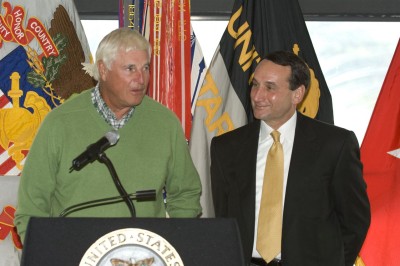
There is a form of historiography, only fairly recently becoming more accepted, called Counterfactual history, or sometimes Virtual history. Counterfactual history is the study not of what actually happened, but rather of how things might have been different had facts or actions along the way been different. The purpose of this brand of study, as I grasp it, is not so much to re-imagine outcomes — that is the stuff of fiction — but is instead to try and game out how changes to recorded history might have altered an alternative future, and then to gauge the real impact of a person, action or incident and what, if any, impact the absence or alteration of them might have made.
For literature and science fiction buffs, in particular, this won’t seem terribly new. For years, authors have for years been imagining what might have happened if some of the most momentous events in history had turned out differently; Or, in some cases, whether the results would have changed anything at all. Writers as diverse as Philip K. Dick and Philip Roth have each done this to great acclaim, and to some derision. And there is no shortage of films that have undertaken similar historical re-imaginings.
Counterfactuals, as these “What if…” scenarios are officially called, are not yet fully embraced by a generally skeptical history community. A few in the field have come to see them as useful tools, akin to forensics, though more seem to see them as little more than a good parlor game. But people in tweed coats with pipes tend to take themselves and their work far too seriously anyway. I should know, I angled to be one of these folks for a few years in the late 1990s. It was great: low pay, unearned respect and plenty of useless arguments. And who doesn’t love themselves a good tweed?
Because I also love a good useless mental exercise and Counterfactual history provides a fantastic one, and since there’s no wrong answer, what’s the harm in applying some Counterfactual historiography to something as benign as college basketball? In truth, gaming out what might have been may actually have some usefulness in looking at the recent historical arc of college basketball. No, seriously.
Unlike life, with all its messiness and repercussions, sport is ultimately nothing but a series of actions taken and their outcomes. The while the results of those actions and subsequent reactions may become the intense focus of the observer (read: fan), no one really cares during a game what a player’s internal wranglings are except, perhaps, coaches and other players. It’s only after the fact that he or she gets asked by breathless reporters, “What were you thinking right then?”
So we look back with an eye toward “What if …”
There are, for me, a few really obvious ones, and not all of these are Kentucky basketball-related. But there is one that is UK-related that I think jumps to be considered right away, if only because of its iconic stature: What if Christian Laettner’s last second game-winner in 1992 in the Elite Eight had bounced long? Beyond the contingent of Kentucky fans whose sausage-encrusted tickers would have stop beating immediately, the impact of such an event is pretty wide reaching for the college basketball world. Most immediately, the 1992 Final Four participant from the East regional changes, with the victorious Wildcat Unforgettables heading on to meet Bob Knight and hated Indiana. For our purposes, we’ll presume that Michigan and Cincinnati still meet on the other side. The questions then follow: Does Knight go on to win a fourth national title and tie Adolph Rupp, further sticking his finger in the collective Big Blue eye? As it stands, Knight never returned to the Final Four at Indiana, or anywhere else.
Or maybe Chris Webber and the Fab Five instead cap their remarkable youthful ascent and win the whole thing as freshmen. That would mean, having later to be forced to vacate their season, they would be the only team to ever have to do so with an NCAA title.
Or, perhaps, Rick Pitino does the unimaginable and rides that Kentucky team to an NCAA championship in his first tournament with the program. When a team that ultimtately lost in the final eight goes on to be called “The Unforgettables” — one of whom would later come with reach of the Governor’s mansion — you can only surmise where those dudes would be today with a shiny national championship trophy added to their collective legacy.
Then again, I suppose we should stick to the stodgy historical model and not extend ourselves into projecting new results. Doing so we can still look at how the landscape would have changed on the this-time-less-than-perfect Laettner shot. Most immediately, Mike Krzyzewski doesn’t march on to a second straight title. Instead, heated rivals Kentucky and Indiana meet in the Final Four for the first time. Knight vs. Pitino. Laettner walks off the floor a loser who missed the big shot rather than Mr. Perfect who never did. That one, I have to admit, I particularly like.
But, of course, there are so many such outcomes to analyze. Every fan of every team who ever lost a big game has one — many more than one, probably. Fun enough, sure; but they hardly deliver much in the way of a deeper analysis. Someone else wins the title, some other coach gets the glory, some other fans the satisfaction.
So where to take our Counterfactuals, then, for a little more significant impact? Maybe we should think bigger than any one game and instead examine the ways in which significant outside decisions that have altered the very nature of the game might have differently influenced hoops history had the facts of those decisions been altered.
The biggest and most immediate one I can think of is what things would have been like had the NBA and NCAA had not colluded to establish an age limit to enter the NBA Draft. One must assume that the run of elite prospects to the NBA would have continued, sucking a significant number of what are now termed “one and done” players into the play-for-pay ranks right out of high school. Based on the experience of the years running up to the 2005 institution of the new NBA Collective Bargaining Agreement’s new draft eligibility rules, what would have ensued is likely an ever-increasing parity, with mid-major programs joining the mix along with the continued dominion of teams heavily laden with seasoned but less-athletic upperclassmen. Fans would never have seen Greg Oden, Kevin Durant, Derrick Rose, Michael Beasley, Eric Gordon or John Wall play a minute of college basketball. Rose and Oden each played in a national championship game, nearly winning, while Durant, Wall and Beasley were each considered by various media outlets as the country’s Player of the Year in their respective single seasons.
College basketball has always been to a degree the safer, slower and more fundamentally sound stepbrother to the NBA. Certainly, elite athletes have made their imprint on the college game — as noted above. But unlike in the NBA, the lesser athlete can, on occasion, overcome the superior one (See also Princeton v. UCLA, 1996). It’s not hard to see that an NCAA devoid of those top tier NBA-caliber athletes is a much-changed one, with so-called “system” coaches finding themselves able to compete more readily with programs who suddenly find themselves without those athletic marvels. In that alternate universe, Bo Ryan, John Beilein and John Thompson III may find new Final Four banners hanging, while Ohio State, Memphis and UCLA must return theirs. OK, so Memphis already has. You get my point.
Or, what if instead of focusing on the negative — i.e., something less debilitating to college basketball’s talent pool — and instead postulate a scenario in which the draft rules had been altered five years earlier, when the NBA’s last Collective Bargaining Agreement had been put into place?
This gets us thinking about LeBron James stuffing baskets with his high school teammates at Akron. Or Amar’e Stoudemire and John Calipari teaming up at Memphis. Man, maybe instead of the butt end of a super-tall joke, kids everywhere would be sporting their replica Kwame Brown Florida Gator jerseys to the O’Connell Center. What fan of the college game wouldn’t have loved to see Dwight Howard and Josh Smith face off in some Sweet Sixteen matchup?
But, of course, it’s not all about which freakishly tall kids would suddenly have been available for rent. In college, where the head coach is the only real continuity a program has, the comings and goings of the most prominent among them have massive impact on the state of the game. From a personal standpoint, I can think of at least one major decision that would have had untold ripple effects on college hoops.
In 2007, under increasing pressure, Tubby Smith bailed from Kentucky for Minnesota, leaving what is inarguably one of the plum jobs in all of college basketball available. Despite what you hear publicly, there was never any doubt that the job was Florida coach Billy Donovan’s to turn down. And turn it down he did. But if Donovan — fresh off back-to-back titles in Gainesville — instead of leaving the Wildcats hanging, takes the Kentucky job, the resulting domino effect on what might have been is pretty entertaining.
Arkansas head coach Billy Gillispie, the doofus who ended up getting the aforementioned plum UK job, would be beginning his fourth season in Fayetteville, The irascible Gillispie would probably have been a good fit there, certainly a better fit there than in Lexington, where his unique brand of gritty, drunken awfulness wasn’t palatable to a fanbase literally desperate for a winner now. Instead of yelling “Sooooeyy!” above a crouching, feverish Gillispie, Arkansas these days continues to plead patience with John Pelphrey, whose lack of sizzle is starting to wear on a once-proud Hawg Nation.
Florida, the two-time defending champion, would have been in the fascinating position of owning consecutive national titles and no head coach. How about the job imaginary Gators coach Larry Brown might have done there? As for John Calipari, can you picture the 2009–10 Memphis Tigers in the Final Four? He can.
I admit such an imagining is self-serving. Similar coaching decisions at North Carolina, Kansas and Indiana have had likewise untold impact on the college hoops landscape, probably moreso. Roy Williams has won two national titles at his alma mater. Does Roy Williams at Kansas today have any? Perhaps still-Illinois coach Bill Self has brought one to Champaign by now. Who knows?
All it’s safe to say is that applying Counterfactual history to college basketball quickly becomes a sport unto itself. The games of “What if …” you could play are endless, and with deep implications for the nature of the sport — from the many game outcomes that would change to the larger alterations to the essence of the sport itself.
Or maybe not? Sometimes winners win despite everything. One thing the college game has always shown is a remarkable ability to reinvent itself despite outside pressures. It has weathered the effects of massive cheating and gambling scandals, on-court collapses, elite talent drain, untimely injuries and ill-advised coaching moves, to name but a few. It still has its annual spring showcase and its four- (or five-) year forced roster rejuvenation. Maybe that’s some inoculation from the forces of inevitability.
Still, there’s no harm in injecting a little imagination into the proceedings, is there? No, says CBS college basketball television analyst and multi-millionaire JL Weill, there most definitely is not.
Originally from Kentucky, JL Weill now writes from Washington, DC. His take on politics, culture and sports can be found at The New Deterrence and on Twitter.
Kissing More Memorable Than Virginity Loss
Science says you remember your first kiss more clearly than the first time you had sex, probably because it lasted longer.
Rich Business Management Consultant Travels to Middle East
Oh look, Mitt Romney is on a tour of Afghanistan, Israel, Jordan and the U.A.E. Maybe he is giving Hamid Karzai some free consulting. (Maybe he’ll run into Joe Biden! Awkwardsies.) New Gallup polling puts him as third, right behind Newt Gingrich, way below Mike Huckabee, in “highest net favorability rating of prospective 2012 GOP contenders.”
Cat Not Amused By Adorable Antics Of Baby Bear
Um, even if you disregard how remarkably cute this whole thing is, let’s be honest: BEAR and CAT together? Fighting? This is pretty much the Awl’s official company video right here.


